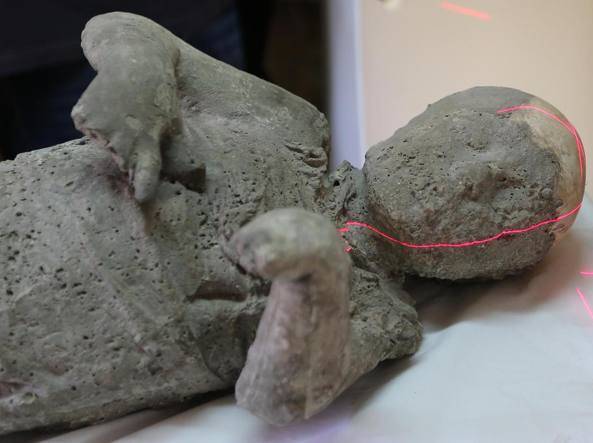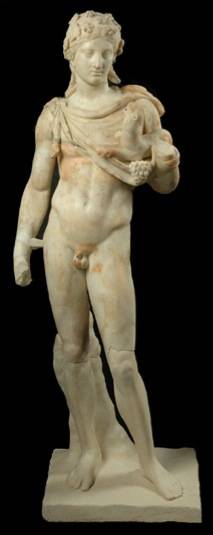Tending to the Heritage
ROME – It has become a truism that Italy has neglected its vast heritage in recent years, but things are looking up. Beginning with Pompeii, the important news is that a team of medical researchers has made CAT scans of the skeletal remains of no less than 30 individuals who died in the eruption of 79 AD. Unlike an X-ray machine, the laser CAT (computerized axial tomography) scan works by building up a series of images which virtually reconstruct the body. In this case, working for the archaeological superintendency of Pompeii headed by Massimo Osanna, a team from the Amsterdam-based Philips SpA Healthcare company used this layer technology to peer through and photograph no less than 16 layers of recently restored plaster casts of bodies so as to build up the series of images into a three-dimensional picture.
Among the objectives was to learn, through serious scientific research of the skeletons concealed within plaster casts, more about the ancient Roman diet. The plaster casts were first made in the 1860s when the former hothead revolutionary patriot archaeologist Giuseppe Fiorelli took over management of Pompeii on behalf of newly unified Italy. In 1853 an excavator at Herculaneum had dug up animal skeletons found inside hollows. The skeletons were all that remained after the organic matter had disintegrated within the solidified volcanic matter, which with rainfall had become a light-weight cement. It was Fiorelli’s idea to pour plaster into these hollows, then crack away the cement-like shell. What he found still stuns the world. Inside a new covered structure in the Pompeii amphitheater the plaster casts are arranged to be seen: a mother clutching her child, a man raised up on his elbow in a last gasp.
Among the findings of this initial study phase was that the ancient Pompeiians had good quality teeth, presumably because their diet was healthy and poor in sugars, but that their bones showed damage from fluorine found naturally in the water at Pompeii. “The density of the plaster made the CAT scan complicated,” Osanna told the press. “The density is almost as great as that of the skeleton.” Conducting the research are not only radiologists and archaeologists, but also dentists, engineers and, in hopes of learning more about life and social classes at ancient Pompeii, anthropologists as well.
Interest in the ancient diet is reflected in recent onsite research by University of Cincinnatti archaeologists under Prof. Steve Ellis, who have been analyzing findings in the sewer systems of both Herculaneum and Pompeii. A surprising discovery was the amount of prepared foods used there, and especially cereals. “These materials have revealed a clear socio-economic distinction between the activities and consumer habits of every home owner,” according to Ellis. “Along with the less expensive cereals, fruits, nuts, olives, lentils, local fish and eggs we have come upon traces of the much more costly salted meats and fish imported from Spain.” Even the residue of (obviously imported) giraffe meat was found by the Cincinnatti University team.
Restorations of the site of Pompeii continue after considerable water damage in the past few years, but Pompeii is not alone. Progress also continues at the majestic Villa Augustea, which lies inland behind Mount Vesuvius at Starza Regina, a village near the town of Somma Vesuviana. Despite lying at the foot of Vesuvius, the villa was not destroyed by the eruption that suffocated Pompeii and Herculaneum.
There for the past 13 years archaeologists from both Naples and Japan have already excavated some 2,000 sq. m. of the villa, or one-fifth of its entirety. “We are bringing to light a very large ancient Roman site where it is believed the Emperor Augustus died,” says archaeologist Antonio De Simone of the Suor Orsola Benincasa University at Naples. The team from the University of Tokyo is headed by Prof. Masanori Aoyagi, working with Prof. De Simone in what is known as the multidisciplinary Apolline Project. A visit to the villa has already attracted some 70,000 tourists particularly interested in seeing state-of-the-art archaeological findings and a new site.
The largest area found so far is a vast hall with on one side a colonnade and, in a wall, two huge niches for statues and, nearby, fine floor mosaics. Wall paintings reflecting the worship of the wine god Dionysius and an exceptionally beautiful marble statue of the god, holding in his arm a baby panther, reflect the archaeologists’ finding that the 10,000 sq. m. estate surrounding the huge villa could produce the exceptional amount of 100,000 liters of wine every year, according to De Simone.
“This extraordinary discovery makes us reconsider the entire history of the cultivation of grapes and wine-making in the whole area,” says Francesco Mosca, president of the Somma Vesuviana Pro Loco, adding that the wall paintings discovered date from the Third century AD, “a period about which we know relatively little.”
The villa was first discovered in the 1930s when farmers happened upon the upper portions of the walls of the villa. At that time precious fragments of statues, wall paintings and mosaics were also found, but when the Somma residents appealed to Mussolini in Rome for funding for excavation, they were turned down.
Post script: those who read Italian and have a special interest in Pompeii may wish to read journalist Francesco Erbani’s Pompei, Italia which studies the recent problems of management and conservation of the site.




































i-Italy
Facebook
Google+
This work may not be reproduced, in whole or in part, without prior written permission.
Questo lavoro non può essere riprodotto, in tutto o in parte, senza permesso scritto.